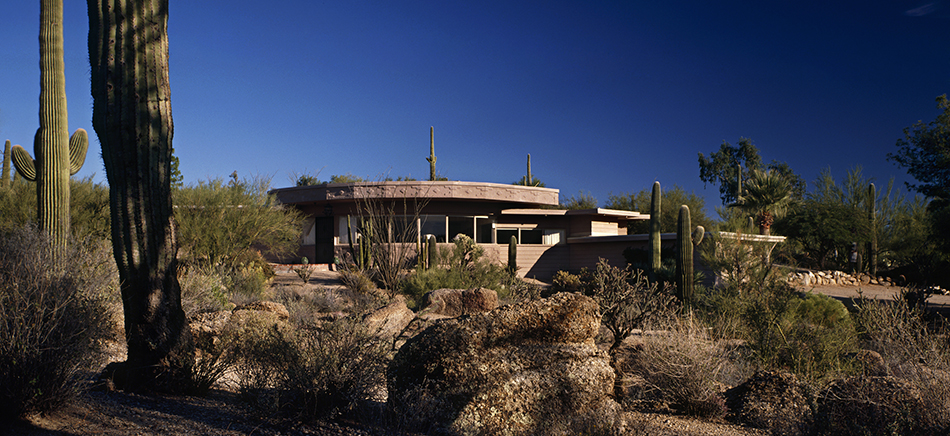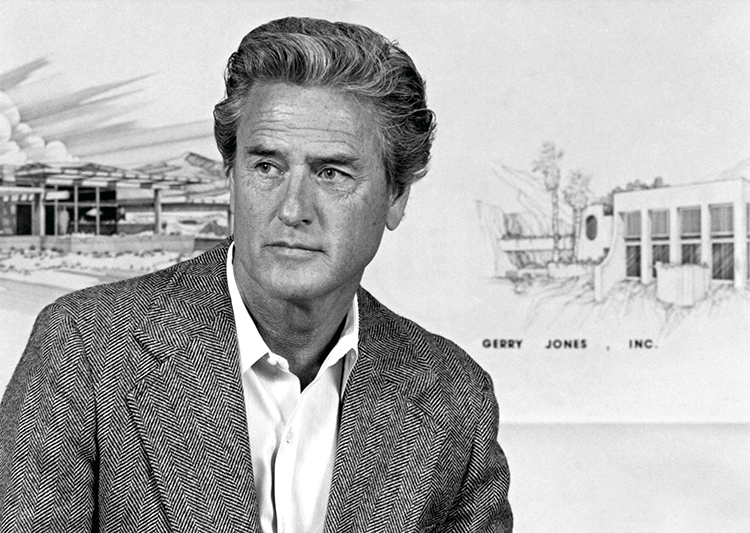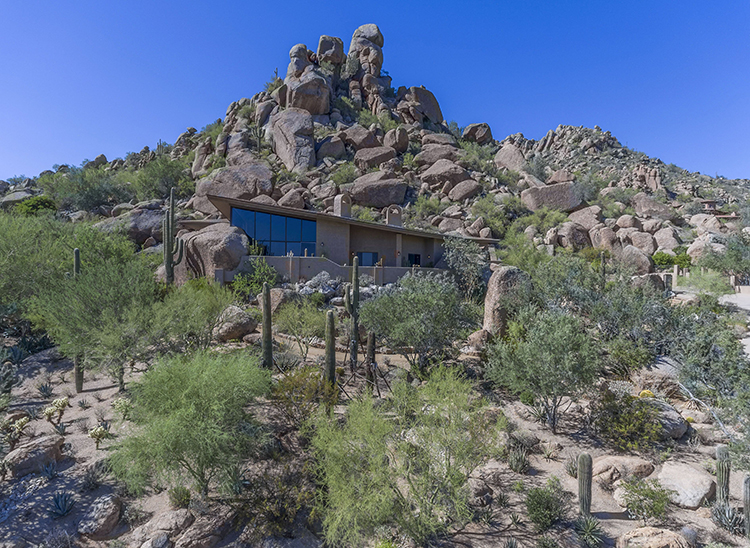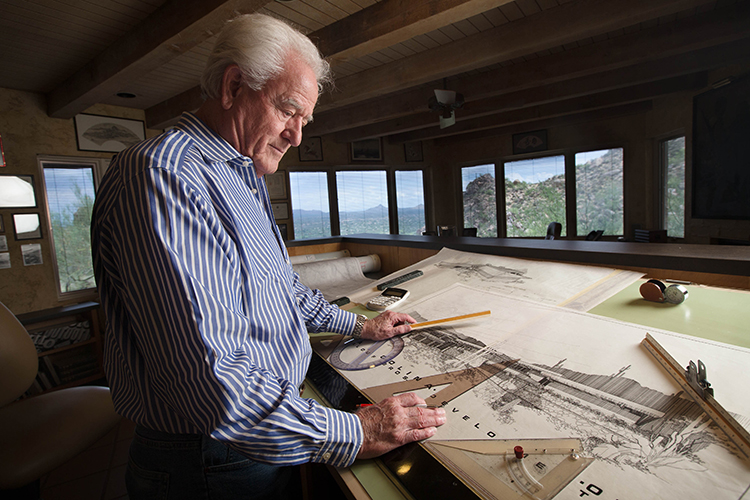Carefree Design: The Legacy of Gerry Jones

Writer Amanda Christmann // Photography by Loralei Lazurak and Bill Watters/Air Major Media
About seven decades ago, two men, KT Palmer and Tom Darlington, had a wild idea. They wanted to create an upscale community in the Arizona desert — the next Palm Springs — where the rich and famous could live and play. They imagined homes integrated into the striking desert terrain, and peaceful vistas where luxury was second only to privacy.
Off of desolate dirt roads left rutted by cattle and horses, the two men found a vast expanse of desert where Precambrian granite outcrops appeared as if they were dropped by giants. Giant saguaros, ocotillos and teddy bear cholla spread bouquets of color through granite and schist crags, hidden by wild groves of mesquites and ironwoods.
They discovered an old goat farm with a well tapped into a sizeable water source, and in 1955, they bought the homestead and its 400 surrounding acres for $44,000.
This would be the place they’d begin their own community — a place like none other.
That place would be Carefree, and in the coming years, Darlington, Palmer and a colorful character named Gerry Jones would turn their little section of Arizona into one of the most famous towns in Arizona.
Growing the Dream
In 1952, Darlington and Palmer found themselves in need of someone who could bring their ideas to fruition. They needed a design architect, and not just anyone with a drafting table would do.
They needed someone who was passionate about creating homes where indoor spaces were seamlessly interwoven with outdoor spaces. They needed someone who could envision something great before a single foundation was poured.
And, to be real, they needed someone determined enough — or naïve enough — to drive 30 miles up bone-jarring dirt roads to hear what they had to say.
Gerry Jones was that man, and when Darlington and Palmer told him they wanted to build luxury homes in what felt like the middle of nowhere, he didn’t blink. Instead, he got to work.



Carefree by Design
Conceptualizing a community like Carefree was not an ordinary endeavor; but then again, Jones is not an ordinary guy.
Born on an Indiana farm during the Great Depression, young Gerry began working the night shift at a bakery at the age of 11 to help his family survive.
He served as a sergeant in the Marines during World War II and Korea, then remained in China, where he was intrigued by Far East concepts of history, politics and philosophy. He studied martial arts and jai alai, and sought answers to questions much deeper than his Midwest roots.
While in Asia, Jones was fascinated by the design and feel of ancient Buddhist monasteries. Instead of being built upon the land, they were integrated with the land. Not only did the natural surroundings remain undisturbed by their construction, it appeared to have become part of the landscape.
This became the foundational principle of Jones’ designs, and it was exactly what Palmer and Darlington were looking for in the creation of Carefree.
What’s in a Name?
Jones didn’t always agree with Darlington and Palmer on the details. In fact, though Darlington and Palmer were enthusiastic about the street names the town is now known for, Jones was not.
Never Mind Trail, Huff N Puff Place, Lazy Lane, Tranquil Trail and more were decided when, at a dinner party, Palmer mentioned that street names had not yet been chosen. As the story goes, jovial guests began contributing their ideas, and so they came to be.
Jones was less than convinced. In fact, he didn’t think anyone would want to live in a place with such silly names.
It was one of the few topics Jones was wrong about, however. Before long, even major nationwide publications were talking about the leisurely community in the desert where one could walk down Easy Street.
Laying the Ground Work
When it came to laying out the roads and plats, like everything else he did, Jones took a bit of an unconventional approach. An avid rock climber, he hiked and climbed through every acre of untamed land, sketching a map as he went along.
He used his rough maps to lay out roads and configure lots. He also documented guidelines, creating rules for development that would eventually become part of the Maricopa County Hillside Ordinance.
In 1958, just one year after the three men shook hands, Jones broke ground on the first two homes in Carefree. The first, located on Bloody Basin Road, was to be the DeMille House. The second home, located on Long Rifle Road, was to be the home of KT Palmer. Darlington’s home would later be built on Peaceful Place.



Houses in Carefree sold for about $80,000 to $90,000, about six times the cost of a home in Phoenix. Though the price was exorbitant at the time, it would have been an incredible investment today. For example, a 2.5-acre improved lot on Black Mountain sold for $2,700 in 1959. Today, it would be valued at about $850,000.
In all, Jones designed and built about 140 homes in Carefree, and about 300 homes in the Valley, including on Camelback and Mummy Mountains, Pinnacle Peak, Paradise Valley, Phoenix, Scottsdale, Clearwater Hills and Cave Creek.
He brought his expertise to Taliesin West’s Frank Lloyd Wright School of Architecture, where, for 17 years, he taught extreme terrain architecture.
His unique style, a bit of Spanish Mission architecture mixed with a more contemporary use of flow, light and open spaces with low-slung rooflines and natural materials, continues to define the community.
Gerry Jones maintains that he is not a founder of Carefree, but looking at the scope of his work and the accomplishments he continues to achieve, the line between founding the community and defining it is blurred.
Hugh Downs, Paul Harvey and Extra Large Underwear
Along the way, Gerry Jones built a life that included experiences that, even decades later, seem a bit surreal. Carefree became quite the spot for the country’s who’s who, and Jones was right in the middle of it all.
Among his memories are times he spent hiking and rock climbing with Hugh Downs. Jones designed a residence for the “Today” and “20/20” personality and his wife, Ruth, and he remembers putting the first repelling bolts in the Carefree boulder pile while Downs’ daughter played below.
In 1968, Downs and Jones decided to build the first fly-in home in America in what is now Carefree Airpark.
After designing, building and decorating it to the nines, the home was marketed as a pilot’s dream. From golf to its own private hangar, it was quite the to-do.
On opening day, Downs flew his plane in and taxied up to the home’s hangar. Aware of his audience, he grabbed his golf clubs and sauntered into the wine reception taking place. It was a large statement — and a brilliant one — but it didn’t work quite as they’d imagined.
As it happened, the home was purchased by Earl Bartholomew, an engineer and inventor who didn’t fly, didn’t have an airplane and was not a golfer. Bartholomew ended up using the hangar as his workshop, where he developed several industrial patents.
Paul Harvey and his wife Angel were also Carefree residents, moving into their home on Lot 266 of Carefree Drive in 1968. The home was built with a sound studio so Paul could broadcast his nationwide program from Carefree in the cold winter months. Paul loved to walk and hike, and Jones often hiked with him.
Once, during his show, Harvey referred to American deaths during a Vietnam battle as “light casualties.” Jones, whose service during World War II and Korea had left lasting impacts, confronted Harvey while the two climbed Elephant Butte, saying that there was no such thing as a light casualty. Harvey never used that term again.
Allan Mayer, heir to the Oscar Mayer company, and his wife, Lois, were considering the purchase of a 20-acre parcel high on Black Mountain in 1972. The problem was that there was no road, and the lot was unimproved.
Jones took the couple on a steep and strenuous climb up the mountain from Stagecoach Pass. For hours they climbed, and when they reached the destination, they looked out over the Valley and took in the breathtaking views.



Glancing into the distance, Jones spotted a dust storm coming in. Keeping his cool, he encouraged the couple to head back down the mountain’s steep slopes. Their descent began too late, however, and they ended up taking cover behind a large boulder.
Winds blew, cholla balls flew into the trio, and they were pounded with rain as they huddled behind the rock. Over the howling of the wind, during the worst moment of the storm, Lois leaned her face into Jones’ ear and shouted emphatically, “No sale!”
The couple instead bought a five-acre parcel in Carefree Highlands. They also bought the Black Mountain lot and donated it to Maricopa Mountain Preserve.
Another story that still brings a laugh happened in 1974 when Carefree residents Ross and Phoebe Slingman rented out their house to Orson Wells. Ross Slingman drafted a strict lease forbidding Wells and his housemate, John Huston, from photographing or filming at the home. They asked Jones to watch over the house in their absence.
Sure enough, the two filmmakers couldn’t resist setting up cameras. Jones reported his discovery of lights on the patio, and Wells and Huston were promptly evicted.
Upon their return, the Slingmans were greeted with a devastating sight. A car had smashed in the front wall of the guest house, and some of their most valuable heirlooms, including a Louis XIV desk, were floating in the swimming pool. The place was all but destroyed, and among the mire were several pairs of Wells’ size 68 underwear.
Once remodelers and time had healed the Slingmans’ wounds, they made the most of the situation. Each year, on the anniversary of the fateful eviction, they ran a pair of Wells’ extra large underwear up the flagpole and enjoyed a bottle of wine.
A Celebration of Legacy
Through the years, Carefree has grown and morphed into a quiet town where the rich and famous still live and play in relative anonymity. Arts and culture have made a resurrection of sorts, as the community has welcomed and nourished an increasing number of artists, musicians and performers.
Jones is the last of the original Carefree trio. He finished his latest home in Black Mountain’s Nighthawk subdivision in 2018, and his signature design has etched its way into the landscape just as sunshine has etched lines in his skin.
March 8, Cave Creek Museum will celebrate its 50th anniversary with the Gerry Jones featured exhibit and a one-day home tour of six unique and outstanding residences he created. Workshops and special events will be held at the museum and at other locations to celebrate Jones’ legacy throughout February and March.
Home tour participants will visit the homes via chauffeured buses in three shifts throughout the day, 9 a.m.–noon; noon–3 p.m.; and 3–6 p.m. Residences are multi-level and are not ADA accessible.
To quote Cave Creek Museum director Karrie Porter Brace, the exhibit and home tour “celebrate the imagination, aesthetic and resolve that initiated and continues to give the desert foothills its wonderful signature character.”
Gerry Jones Home Tour
Sunday, March 8 | 9 a.m.–noon; noon–3 p.m.; 3–6 p.m. | Tickets $75; available at Cave Creek Museum | 6140 E. Skyline Drive, Cave Creek
480-488-2764 | cavecreekmuseum.org
Gerry Jones Featured Exhibit
Wednesdays and Thursdays 1–4:30 p.m. | Fridays 10 a.m.–4:30 p.m. | Saturdays and Sundays 1–4:30 p.m. | Cave Creek Museum
6140 E. Skyline Drive, Cave Creek | 480-488-2764 | cavecreekmuseum.org
